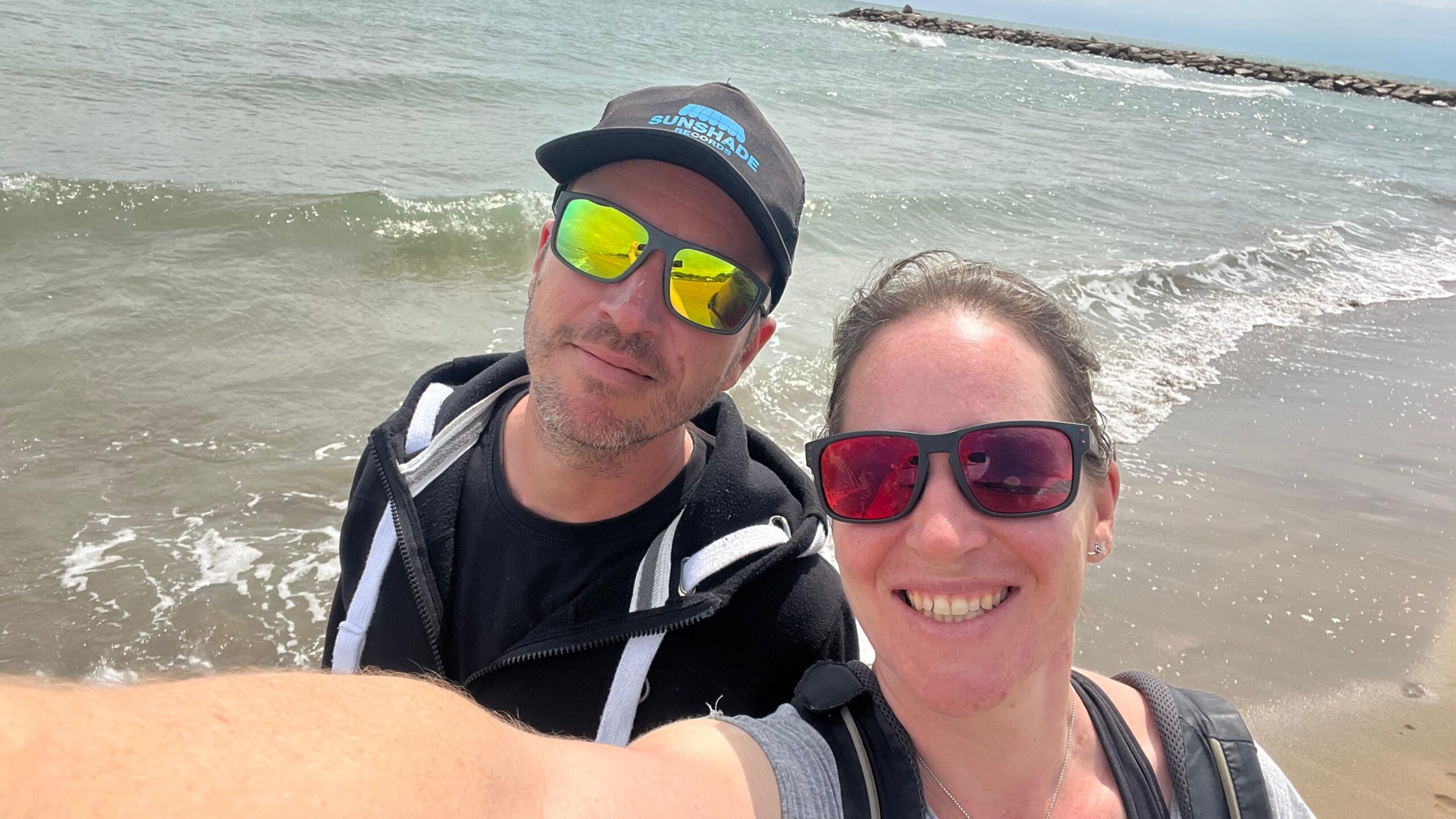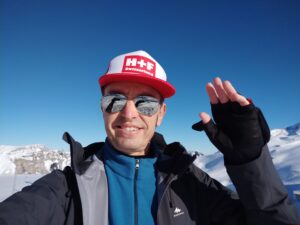The topic of trimming paragliders and its effect on flight behaviour and ultimately also on safety has been the subject of intense discussion in the scene for several years now. Nevertheless, for most pilots, checking and re-trimming paragliders seems to be a job for the check centres. How can pilots be enabled to check the trim and how can they be supported in trimming their own glider? Nora Martiny and Benjamin Lutze must have thought about this and much more, and their answer: the website we-measure.io.
Ad Nubes: Nora, Benjamin, how did you come up with the idea for we-measure?
Nora: The idea came about when we had our gliders trimmed at the beginning of 2023 and were not satisfied with the result after an unbearably long wait for flight addicts. As we found the existing Excel solutions not particularly intuitive, Nora is a technical project manager and Benjamin is a web developer, we bought a laser and started designing a web application. Together, we used the long period of bad weather in spring 2023 to get the first version of we-measure.io up and running.
Ad Nubes: What are the visions and goals behind we-measure?
Benjamin: The vision emerged from the development process. At first, we just wanted to create something that, as far as we knew, nobody had done before: a web-based platform for measuring paragliders. In our dealings with the various manufacturers, we then realised that there was a great need for standardised storage and display of line plans, which has long been a recurring theme among long-standing experts in the industry, such as Ralf Antz. One aim is therefore to offer a platform from paragliders for paragliders (and perhaps at some point also manufacturers and check centres) in order to move away from 1000s of individual Excel solutions – towards a “common” solution from which everyone can benefit. The more people provide data, the better the simulation of different nodes can be, for example. Hence the “we” in our name. Nora lived in Asia for several years and saw how little the topic of “paraglider checks” was present there until then. Another important point is that the global standards in terms of airworthiness still have a lot of catching up to do compared to Central Europe. With our internationally orientated platform, we would therefore like to ensure better awareness worldwide and offer a reasonably simple way to help yourself. Official check centres or manufacturers should, of course, always be the first port of call.
Ad Nubes: Why is it always necessary to measure the trim on a paraglider?
Nora: The different lines of a paraglider are exposed to different loads depending on the position of the suspension point. This applies both to normal flight and also, to a greater extent, to special stresses such as winch towing or spiralling. As a rule, the main load is on the inner A-lines, while the stabilo or the rear line level, for example, experience significantly less load. Over time, this creates an imbalance in the glider: the lines with more load tend to lengthen, whereas those with less load tend to shorten. The materials used as well as the material mix (Dyneema vs. Aramid etc.) or environmental factors also play a role here.
In order to counteract the potentially fatal deviation from the factory setting angle of individual areas or the entire wing due to different deviating lines, the relative deviations between the individual lines compared to the target setting must be determined by measurement and corrected by the subsequent trim. The newly set trim is then checked again with a final measurement.
Ad Nubes: From your point of view, why should you measure the trim of the glider yourself? Isn’t it better to leave the trimming to the check companies?
Nora: Of course, the first port of call should always be a qualified check centre if you have access to one. However, this is not always the case outside of Central Europe. There may also be other situations in which an independent measurement can be useful. We see this particularly with competition pilots who want to check the trim of their glider during a competition (where more than 50 hours can be flown). A measurement by the pilot himself can also serve as a basis for deciding whether it makes sense to send the glider in for trim tuning or not. There are also pilots who want to understand how their glider has changed over time and what effect changes made by a check organisation have. For this we have an import function that provides a quick visual overview.
Particular care and a critical look at your own work are urgently required for homemade measurements.
If there is even the slightest doubt that your own measuring equipment or your own skills will lead to results with the necessary accuracy, you should definitely refrain from estimating the trim or trimming yourself!
There are many sources of error. We recommend that all pilots inform themselves thoroughly before taking their first measurements and/or trimming, attend a course if necessary or seek advice from professionals.
Ad Nubes: How often should you do the trimming yourself? Do you have any recommendations, e.g. for the competition pilot, the normal local mountain pilot or the ambitious cross-country pilot?
Nora: The recommended trim and check intervals are usually specified by the manufacturer in the manual. In addition, a check always makes sense if the glider has been exposed to unusual stresses, e.g. after a tree landing, safety training, contact with water, or if you have the impression that the take-off and/or flight behaviour is different than expected.
Ad Nubes: Who is the main target group of We-Measure.io? Is it mainly paraglider pilots, manufacturers or workshops?
Benjamin: Our current focus is on pilots and check operations. However, we would be delighted if we could also get manufacturers on board directly in the future.
Ad Nubes: Have any manufacturers already contacted you and expressed interest?
Nora: There are manufacturers who have proactively contacted us and offered their help, or who find our concept interesting and good. In general, we get a lot of support and friendly feedback when we ask for screen data. That is already a great success and a vote of confidence. Only time will tell.
Ad Nubes: Which manufacturers have contacted you proactively, can you name a few? Are there also manufacturers who are rather hesitant to support you or perhaps not at all?
Benjamin: We don’t want to name who has been in contact with us at this stage. Most of the manufacturers’ data is available to everyone. We asked Gin Gliders Inc. right at the beginning and were given a small selection of competition wings and high performance wings to try out.
In the meantime, however, we have reached the point where we can request all length data from Gin and also publish it. ADVANCE Thun AG does not yet want its paraglider data to be published on third-party websites, as it takes a critical view of the concept of DIY measurement of paragliders. As already indicated, the professional measurement of a paraglider involves more than a laser and 5 kg of weight. We can therefore well understand this point of view. However, as owners of paragliders have a fundamental right to the length data, Advance naturally also makes this available via an automated request and we can allocate the models to users on request.
Ad Nubes: What does the automated enquiry look like? In which format is the data available? Is the retrieval process the same for all manufacturers?
Nora: The format that is provided in the screen data varies depending on the manufacturer and age of the screens, usually it is in XSLX, PDF or an image file. Most manufacturers provide the data in one form or another for download on their website. With others, data is only available on request via e-mail, sometimes even only with the serial number of the glider.
Ad Nubes: If you get the data in so many different formats, do you think it’s necessary to type them into a database by hand? Or can the different formats be automatically converted into a suitable format?
Benjamin: Not quite. Fortunately, the data usually comes in tabular form. However, not exactly as we need it. That’s why we first bring the different data supplied (e.g. with copy & paste) into a standardised form as XLSX. We then use our XLSX import to import the line lengths and suspension point names into the data records we have created. These data records are structured in such a way that the system knows which suspension points belong together in different groupings and which do not. Depending on the quality and accessibility of the data supplied by the manufacturer, we need between 30 minutes and 2 hours to create a model including all sizes.
Ad Nubes: You’ve already briefly explained how you came up with the domain “we-measure”, but why do you use the top-level domain “io” (io stands for British Indian Ocean Territory)?
Nora: The top-level domain IO actually belongs to the Chagos archipelago, yes. However, our server is not located there.
However, I/O or IO is often used in the computer world for input/output and the top-level domain is almost exclusively “misused” by technology companies. With IO, we wanted to express the fact that data can be read directly into the website and analysed. We deliberately did not choose DE because, in addition to Nora’s experience, we realised early on in a very small-scale survey that we would not primarily serve a German-speaking audience.
Ad Nubes: Are there any plans to make the website multilingual?
Benjamin: There are currently no plans to do this. We are currently focussing more on further improving comprehensibility, validation and therefore quality & security and on making the English content more comprehensive and easier to understand. Because we still see a lot of potential there.
Ad Nubes: I hope that the interview will also give pilots who perhaps can’t read English very well an introduction. How popular is your website now? What is the number of daily visitors and overall since the website was launched?
Nora: Since the beginning of 2023, the average number of daily visits has risen from 40 to over 200, 79% of which are from non-German-speaking countries. Over 1000 users, 860 of whom have created at least one screen in their profile
Over 2400 completed measurements with over 2500 length changes.
By the way: Some of our users translate the page into their native language using the translation function integrated in many browsers. This works quite well. At least if you don’t pay too much attention to grammar ;o)
Ad Nubes: Which clamping device do you use for your measurements? Which fixture would you recommend to someone who wants to buy a fixture?
Benjamin: Back then, we designed something ourselves that worked well for us.
In the meantime, we have found some good devices, which we have also listed in our FAQ: https://we-measure.io/faq#filter=equipment.
It is important to verify your equipment so that you get reproducible measurement results.
We have also collected some points that you need to pay attention to when measuring in our FAQ: https://we-measure.io/faq#filter=reliable%20measur
Ad Nubes: With the simple solutions, you have to hold the laser measuring device in your hand. Is it advisable to mount the laser measuring device on a rail?
Nora: A measuring device based on rails on both sides is undoubtedly the best solution! This is the only way to eliminate the vast majority of sources of error. Unfortunately, for many people the limited space in their home or similar speaks against such a solution.
Ad nubes: In physics lessons you learnt to repeat a measurement several times in order to calculate an average value to eliminate random errors. Is that also your recommendation? Is averaging supported by the software or is something like this being planned?
Benjamin: Unfortunately, the answer is not quite so simple. The correctness of the measured value depends primarily on the measurement setup and the measurement method. Unfortunately, there are scenarios in which even an average value would not improve the quality of the result. These have to do with the common weaknesses of one-sided fixed measurement setups.
Therefore, we have so far taken the view that it is more important to design the measurement setup with a minimum of error potential, e.g. by making the laser target as small as possible, and to refine your own measurement method.
Ad Nubes: If you have changed the trim. How can the changed trim be checked? My idea would be, for example, by measuring the speed in flight. What is your recommendation?
Nora: The only objective way to assess the trim is to carry out a high-quality control measurement of the newly trimmed lines and the associated assessment of the relative deviations from the manufacturer’s nominal values.
A good trim not only affects the speed of the glider, but also, for example, the take-off behaviour, collapse susceptibility, turning behaviour, glide performance, entry into thermals, etc. However, these are sometimes quite subjective preferences that can be taken into account within the given tolerances of the trim. However, as these nuances are primarily based on experience with the respective glider models, we recommend consulting an established check centre if necessary.
Ad Nubes: Does it help to inspect the bottom sail in flight, e.g. for kinks or waves in the bottom sail? Of course, this only works with a 3-liner.
Nora: Unfortunately, we have no experience of this. However, we think that such deformations could also have other causes. If in doubt, you should always consult a check centre or the manufacturer.
Ad Nubes: Do you analyse the measurement results or compile statistics from them? Have you already drawn any conclusions?
Benjamin: So far, we have mainly been analysing the reliability of the simulation. We do this by comparing the assumed changes in length with the actual changes in length. Our conclusions are then incorporated into the simulation, provided the data appears plausible and is available in sufficient quantity. In this way, every user with good measurement quality contributes to gradually improving the simulation. We are currently working on a method to find out how reliable the data supplied is. We have not yet collected statistics on setting angles and other deviations.
Ad Nubes: During the trim check, certain lines are broken and replaced with new ones. Does this make sense from your point of view? Have you noticed any negative consequences, e.g. different changes in the length of the old lines compared to the new ones?
Nora: No, we have no personal experience of this. Check centres can certainly report more detailed experiences here. However, we do think that these checks make sense. We have often heard of torn (older) lines after rattling.
Ad Nubes: What feedback have you received so far from paraglider pilots or workshops? Is there any feedback and suggestions for improvement for the measurement and trim from the users?
Nora: The feedback was largely very positive. In particular, it was repeatedly mentioned that the graphical display makes trimming easier and is intuitive overall. Competition pilots in particular were also delighted that they can measure their glider anytime and anywhere without a laptop, for example. We also receive many suggestions for improvements, which we are gradually incorporating where appropriate. Examples include the integration of new laser devices (most recently, for example, the Leica Disto X3 or the skyLine system), the addition of the pile hitch as a knot in addition to the anchor stitch + loop, the measurement of brakes, etc. etc. We are always happy to receive ideas from our users.
Ad Nubes: Do you only finance your project through donations or do you have other sources of income? How big is the willingness to donate?
Benjamin: In principle, there is nothing to finance in our project, apart from the time we invest. The running costs are very low. We are very satisfied with the support we receive and are always happy to receive coffee or even a crate of beer.
Ad Nubes: You’ve already mentioned a few more features based on feedback. Are there any other functions that you are planning to realise?
Benjamin: We are currently working on some primarily statistical functions and aids, such as an evaluation of the measurement accuracy or an evaluation of the setting angles across all measurements of a model. An aiming aid for the measurement process is also being trialled. In addition, various smaller topics are being planned to improve user-friendliness.
Ad Nubes: Is there anything else you would like to tell paragliders or the community about We-Measure.io?
Nora: We created we-measure.io and made it available to the community because we want to give something back. We all benefit from the voluntary work in our clubs or at the DHV, from idealists who have made our sport safer and safer over the years and, last but not least, from the weather, which has become increasingly extreme in recent years.
Virtually nobody has made a fortune from this sport so far. But many people have found their lives enriched by it. As I mentioned at the beginning, our main aim was to increase safety in less well-off parts of the world by empowering and encouraging pilots to check the safety of their own equipment.
So our message to the community is: help each other, listen to each other, be open to new people and new experiences. Let’s not only make the sport safer for everyone, but also create a friendly and open environment together. And let’s protect this world, which we all love so much from above, like the apple of our eye.
Ad Nubes: Very nice closing words. I would like to thank you for the interesting interview and even though your project is driven by a lot of idealism, I hope that donors will be found to support your project.
Benjamin: Thanks Oliver, for us, as non-PR people, it was also a very interesting process!
Nora: Thank you very much for the interview and your patience with us! It was a lot of fun!
The interview was conducted via Whatsapp.
Nora and Benjamin have put a lot of work into their project, so a donation if you use the service would be more than justified. But I also put a lot of work into my blog, even though this time the interview was conducted via WhatsApp and I didn’t have to transcribe it. You can find out how you can donate to we-measure on their website under Vision, and how you can donate to me in the Support menu. Thank you very much.




